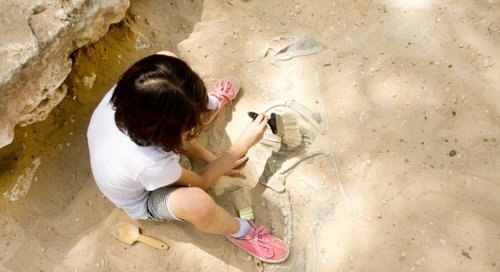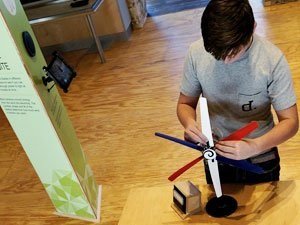Little League, fishing, theater camp—for kids, summer can be a time to enjoy hobbies and explore new interests. In the Science Mill’s work with STEM professionals, we often hear how these childhood passions inspired later career choices. In fact, that idea helps shape the Science Mill’s exhibits: we create fun, hands-on experiences with authentic tools and real-world challenges that let kids step into different STEM careers. Think of your museum visit as a STEM career sampler! Botanists, programmers, astronauts—who will your kids be? Come see what sparks curiosity. Whether it becomes this summer’s obsession or the start of something bigger, the Science Mill has resources to help you nurture their interests. We’ve put together a list below of some favorite exhibits and paired them with STEM activities to support further exploration after your visit. And don’t hesitate to contact our Education team for more ideas! You can also find STEM activity kits and books in the Mill’s Science Store, onsite and online.
***
Fossil Dig / Jurassic Flight 4D / Dinosaurs of Antarctica
Spark an interest in: geology, paleontology
This dino-mite trio is a must-do for many visitors. In the outdoor Fossil Dig exhibit, kids become paleontologists as they use shovels and brushes to uncover fossil replicas and try to identify the prehistoric creatures they’ve unearthed. From hands-on to high-tech, Jurassic Flight 4D combines richly detailed virtual reality and a full-body motion board to create the seamless sensation of soaring through a world of dinosaurs. Stop by the front desk to sign up for your flight; Jurassic Flight 4D is now located in Studio 2. (And something *NEW* is coming in its former spot soon!) Our current science movie, Dinosaurs of Antarctica, takes kids to Earth’s coldest continent as part of a team of scientists on a quest to uncover the amazing animals that lived there hundreds of millions of years ago. June is the last month to catch this special feature! While all these experiences fuel kids’ interest in dinosaurs, they also introduce geology, environmental science, and Earth systems. CGI recreations and 4D experience showcase biomechanics, computer programming, and the intersection of art with STEM.
Take it further: Explore the prehistoric Hill Country
Pair your museum visit with a family road trip that explores the geological history of the Hill Country. Numerous state parks are just a short drive from the Science Mill. Kids age seven and up can hunt for real fossils and dinosaur tracks on the Canyon Lake Gorge Tour, or stop at the Heritage Museum of the Texas Hill Country for fossil exhibits and model dinosaurs.
***
Incredible Ball Machine / Race Track /
Sailboats / Wind Turbine Test Bed
Spark an interest in: physics, engineering
These are just a few of the Science Mill exhibits where kids can experiment with energy and motion. The one-of-a-kind Incredible Ball Machine seems like a madcap mini roller coaster, but look closely to spot pulleys, levers and other simple machines you can control. Try to predict the path each ball with take! At the Race Track, design, build and test drive a custom car that combines the basics of mechanical and electrical engineering. Wind power gets things moving at the Wind Turbine Test Bed and Sailboats exhibits. Try out different combinations to see what makes things move farther or faster—you’ll be problem-solving like engineers, mechanics, renewable energy technicians, and physicists!
Take it further: Rube Goldberg Challenge & more ways to tinker
Take inspiration from Rube Goldberg—a cartoonist known for drawing elaborate machines designed to do simple, silly tasks—and set up your own crazy contraption using everyday items. Check out our Explorer Zone feature for examples and additional activities. Or, compete in the Simple Machines Olympics!
***
Critter Bots / Colossal Robotic Hand / Go with the Flow
Spark an interest in: computer science, robotics
Hooves stamp, claws dig and rattles shake when you bring the Critter Bots to life with the basics of coding. Stack digital blocks—each with a simple instruction like “move head up,” “repeat 2x,” “wait 3 seconds”—to build a custom program. At the Colossal Robotic Hand, the see-through controller lets you peek at potentiometers and circuitry as you send an “extra high” five. Think like a programmer: what sequence of moves would you have the hand follow to take on a new pose? (Hint: we had to program the hand to make sure joints move in sequence and fingers don’t bang into the thumb.) For a closer look at circuits, the Go with the Flow exhibit lets you experiment with the flow of alternating current (AC) and direct current (DC) electricity.
Take it further: Coding apps, robotics & “offline” programming
Scratch and Hopscotch are two free programming platforms where kids can experiment with the basics of coding to play and create games, animated stories and more. Visit our blog for teen-approved tips for getting started with programming and robotics. Concerned about screen time? Build problem-solving skills offline using the Engineering Design Process or creating a paper prototype robotic hand.
***
Masters of Disguise / Virtual Body Table /
Aquaponics Greenhouse / Chemical Reactions
Spark an interest in: biology & life science, chemistry
In the Masters of Disguise exhibit, take a closer look at animals that blend in, stand out, confuse the eye or hide in plain sight. How might scientists, inventors and designers draw inspiration from these wild adaptations? Brainstorm ideas throughout the exhibit! Be sure to check out the other hands-on experiences in the BioLab as well. The Virtual Body Table lets you look at how bodies work, inside and out, thanks to 3D models created from CT scans. From body systems to ecosystems, find out how we grow plants without soil in the Aquaponics Greenhouse, which combines hydroponics (growing plants in water) and aquaculture (raising fish). While lush plants take the spotlight, it’s a chemical cycle behind the scenes that keeps things growing. You can explore more chemistry at the Chemical Reactions exhibit, an interactive touchscreen where you can digitally experiment with nitrogen, hydrogen, oxygen and other “building blocks of life.”
Take it further: DIY hydroponics & citizen science projects
The Explorer Zone has instructions for growing your own plants without soil; if your family is really inspired, we also have tips for setting up a full aquaponics system! Spend time observing wildlife in your backyard (or one of the state parks we mentioned earlier) and use the iNaturalist app to identify what you find. You’ll also find nationwide projects where you can join other citizens in sharing observations that aid scientists.













